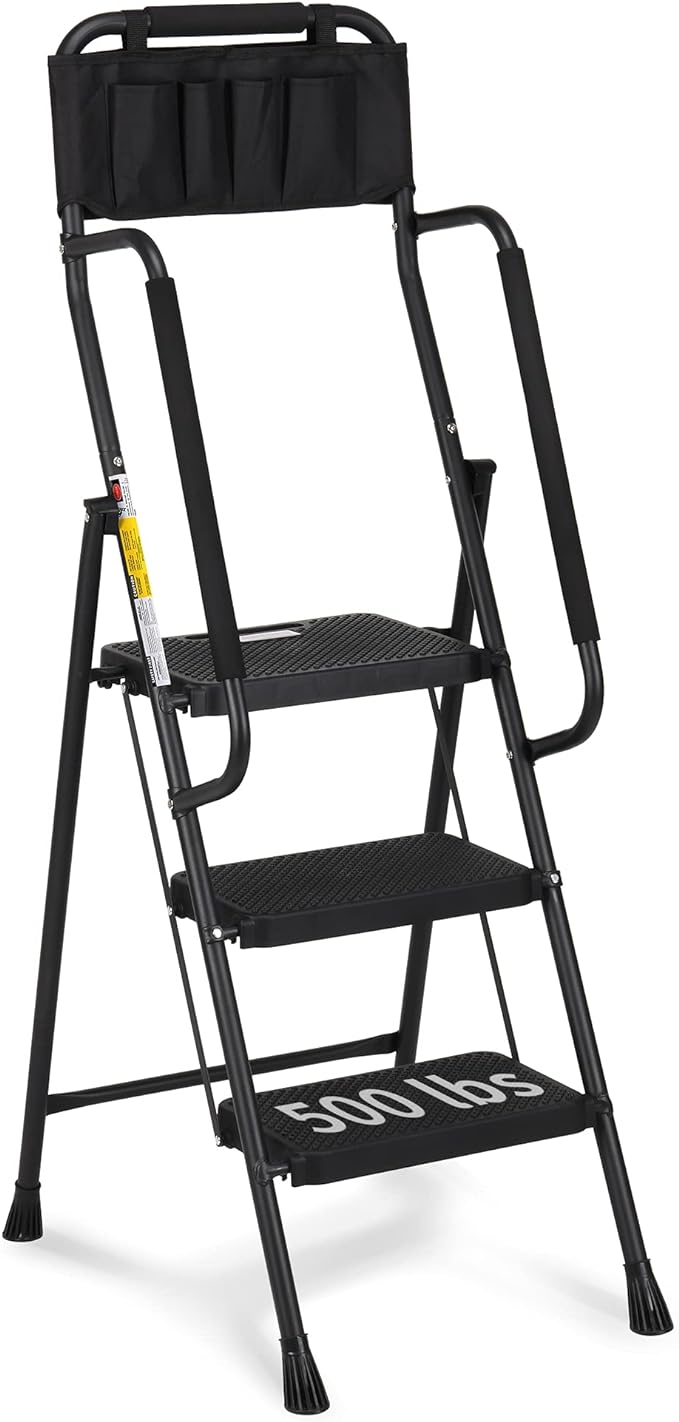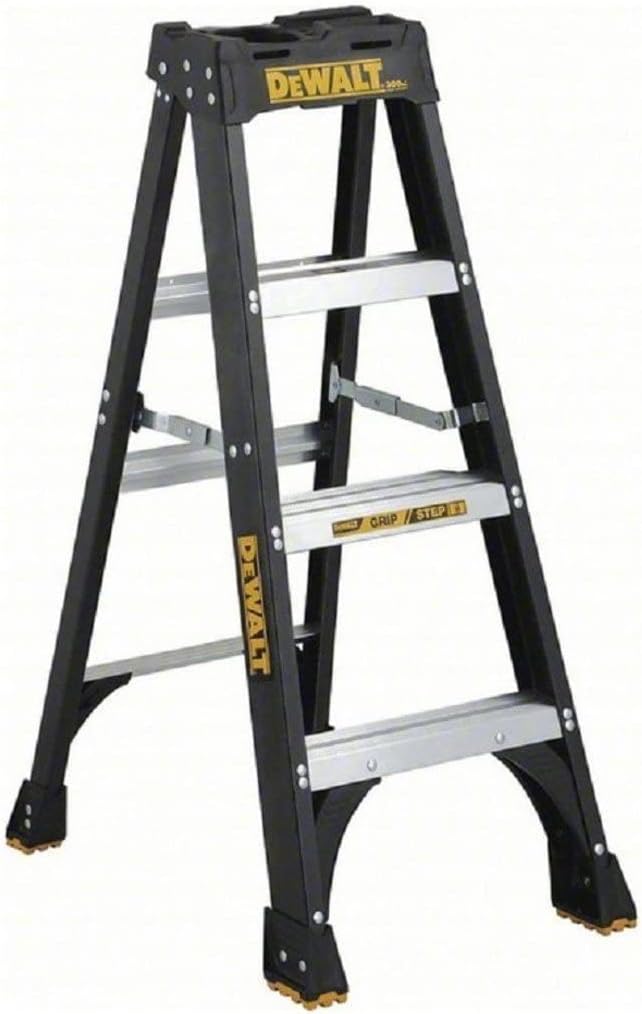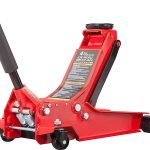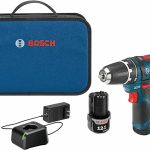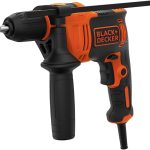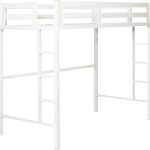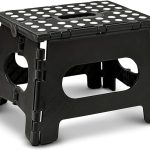As you stand at the threshold of your next DIY project, the question echoes: what’s the best ladder for the job? The answer, much like the rungs of a ladder, is multifaceted. With a plethora of options available, it’s essential to separate the wheat from the chaff. But fear not, for we’ve done the heavy lifting for you. Ahead, we’ll explore the top four ladders that will elevate your work – and safety – to new heights. But first, which of these heavy-hitters will reign supreme: the Louisville Ladder’s sturdy design, the DeWalt’s clever storage, the Little Giant’s versatility, or the HBTower’s stability?
Contents
Louisville Ladder FE3216 Foot Extension Ladder, 16 feet, Orange
The Louisville Ladder FE3216 Foot Extension Ladder, 16 feet, Orange, is an excellent choice for professionals seeking a reliable and durable extension ladder for electrical, utility, light construction, or residential jobs.
This ladder offers a load capacity of 375 lbs and a range of innovative safety features.
This ladder’s design prioritizes your safety with its non-conductive fiberglass material, MAXLOCK rung lock, and QuickLatch system for securing the ladder.
The D-shaped rungs have a fully serrated surface for slip resistance, while the Wivel safety shoes feature overmolded polymer tread for stability.
You’ll appreciate the extra heavy-duty slide guides that prevent over-extending, making it easier to focus on the task at hand.
With a maximum height of 192 inches and a weight capacity of 375 lbs, this ladder is ready to support your work demands.
Best For: Professionals seeking a reliable and durable extension ladder for electrical, utility, light construction, or residential jobs.
Pros:
- Offers a load capacity of 375 lbs and a range of innovative safety features
- Prioritizes safety with non-conductive fiberglass material, MAXLOCK rung lock, and QuickLatch system
- Features extra heavy-duty slide guides that prevent over-extending and Wivel safety shoes with overmolded polymer tread for stability
Cons:
- No specific cons mentioned in the product description or customer reviews
- No specific cons mentioned in the product description or customer reviews
- No specific cons mentioned in the product description or customer reviews
Little Giant Velocity Multi-Position Ladder
The Little Giant Velocity Multi-Position Ladder offers exceptional versatility, converting to A-frame, extension, trestle-and-plank, 90-degree, and staircase configurations with ease, making it an ideal choice for professionals and DIY enthusiasts who need a reliable and adaptable ladder.
With its wide-flared Ratchet leg levelers, you can adjust to uneven terrain in seconds, and the Rock Lock adjusters quickly alter the ladder into different configurations.
The Tip & Glide wheels make it easy to transport the ladder from job to job.
As a Type IA ladder, it’s rated to hold 300 lbs, and its lightweight aluminum construction makes it easy to maneuver. Weighing only 35 pounds, this ladder is a great option for those who need a reliable and portable ladder.
Best For: Professionals and DIY enthusiasts who need a reliable and adaptable ladder that can convert to different configurations.
Pros:
- Exceptional versatility, converting to A-frame, extension, trestle-and-plank, 90-degree, and staircase configurations with ease
- Wide-flared Ratchet leg levelers and Rock Lock adjusters for quick adjustments on uneven terrain and different configurations
- Lightweight aluminum construction and Tip & Glide wheels for easy transport and maneuverability
Cons:
- Some customers mention the ladder’s weight as a drawback
- Lack of durability is mentioned by some customers
- No specific warranty information is provided
HBTower 3 Step Ladder with Handrails
The HBTower 3 Step Ladder with Handrails is an ideal choice for homeowners and DIY enthusiasts who need a reliable and convenient ladder for various tasks around the house, with its sturdy alloy steel frame and attachable tool bag.
You’ll appreciate the ladder’s stability and safety features, including the metal safe buckle that automatically locks in place and the back cross brace that reinforces support.
The anti-slip wide pedal and rubber feet provide stability and prevent scratches on the floor. The ladder’s design helps to maintain traction, and the rubber feet protect the floor from damage.
With a capacity of 500 pounds, this ladder is suitable for most users.
The tool bag attachment is handy for storing your essentials, and the sponge-covered handrails provide a soft feel and better friction.
At 16.1 pounds, it’s also lightweight and portable.
Best For: Homeowners and DIY enthusiasts who need a reliable and convenient ladder for various tasks around the house.
Pros:
- Stable and safe design with metal safe buckle, back cross brace, and anti-slip wide pedal and rubber feet
- Convenient attachable tool bag for storing essentials
- Lightweight and portable at 16.1 pounds with a capacity of 500 pounds
Cons:
- No specific drawbacks mentioned in customer reviews
- May not be suitable for heavy-duty commercial use
- Assembly required, which may be a challenge for some users
DeWalt DXL3010-04 Fiberglass Stepladder, 4-Feet, Black
The DeWalt DXL3010-04 Fiberglass Stepladder is the best choice for professionals and DIYers who need a sturdy and feature-rich ladder that can support up to 300 pounds, making it an ideal option for heavy-duty users.
With its extra-wide steps providing 25% more standing surface, you’ll feel secure and comfortable while working.
The WORK STATION system features a magnet tray, hardware tray, curved front, drill and tool slots, paint bucket holder, and pipe or 2×4 holder, making it a convenient and organized workspace.
Weighing only 14.1 pounds, this 4-foot ladder is easy to transport, and its non-marking slip-resistant shoes provide added grip on various surfaces.
Best For: Professionals and DIYers who need a sturdy and feature-rich ladder that can support heavy loads.
Pros:
- The ladder has a 300-pound capacity, making it suitable for heavy-duty users.
- The extra-wide steps provide 25% more standing surface, ensuring a comfortable and secure working experience.
- The WORK STATION system features a range of convenient and organized storage options, including a magnet tray, hardware tray, and paint bucket holder.
Cons:
- Some customers have reported minor issues with scratches and scuffs on the ladder.
- The ladder may not be suitable for users who require a higher maximum height, as it only reaches 23 inches.
- The warranty, although 3-year limited, may not provide adequate protection for some users.
Factors to Consider When Choosing Ladders
When choosing a ladder, you’re not just looking for any old rung to step on – you need one that meets your specific needs.
You’ll want to ponder a few key factors to guarantee you’re getting a ladder that’s safe, reliable, and gets the job done.
From load capacity to material durability, safety features to height and reach, you’ll need to weigh your options carefully and deliberate on the best choice.
Load Capacity Matters
As you prepare to tackle a task that requires a ladder, remember that the ladder’s load capacity is the most critical factor in guaranteeing your safety while working at heights.
You need a ladder that can hold your weight, plus the weight of any tools or materials you’ll be using. The American National Standards Institute (ANSI) recommends a minimum load capacity of 250 pounds, but you may need more if you’re heavier or plan to carry heavy gear.
Don’t just look at the manufacturer’s specs, though – consider the ladder’s material and construction, too. A sturdy, well-built ladder can support a higher load capacity than a flimsy one.
When choosing a ladder, check the manufacturer’s specs and look for certifications from reputable organizations like OSHA or ANSI. This guarantees the ladder meets necessary safety standards.
Material Durability Counts
You’ll want to think about the durability of a ladder’s material, as it’s a crucial factor in determining its overall strength and reliability.
The type of material used can greatly impact the ladder’s performance and longevity. For instance, fiberglass ladders like the Louisville Ladder FE3216 are non-conductive, making them ideal for electrical, utility, and light construction work.
Aluminum ladders, such as the Little Giant Velocity Multi-Position Ladder, are lightweight and durable, but mightn’t be suitable for heavy-duty use.
On the other hand, steel ladders like the HBTower 3 Step Ladder are strong and sturdy, but may be heavier and more prone to rust.
The durability of a ladder’s material also affects its weight capacity. Higher weight capacities often require more durable materials.
Additionally, the type of material used can impact the ladder’s maintenance needs. Some materials may require more frequent cleaning or replacement than others.
When choosing a ladder, consider the material’s durability and how it aligns with your specific needs. By doing so, you’ll be able to select a ladder that meets your requirements and provides years of reliable service.
Safety Features First
Prioritize safety by looking for ladders with features that put your well-being first, as a single misstep can have serious consequences.
You’ll want to explore ladders made from non-conductive materials like fiberglass, which reduces the risk of electrical shock. The Louisville Ladder FE3216 is a great example, with its non-conductive fiberglass construction.
Look for features that secure the ladder and prevent accidents. The MAXLOCK rung lock and QuickLatch system in the Louisville Ladder FE3216 are great examples of this.
You’ll also want to examine ladders with stability-enhancing features like Steel Swivel Safety Shoes with metal shields, which provide traction on uneven surfaces. The Louisville Ladder FE3216’s Wivel safety shoes with overmolded polymer tread are another great example of this.
Height and Reach
Considering the safety features of a ladder is only half the battle; now it’s time to think about the task at hand and determine the maximum height you need to reach.
You’ll want to choose a ladder that can get you to the desired height, whether it’s to change a light bulb or paint a ceiling. Different ladders have varying maximum heights, so make sure to check the specifications. For example, the Louisville Ladder FE3216 Foot Extension Ladder can reach up to 192 inches, while the Little Giant Velocity Multi-Position Ladder can reach an impressive 204 inches.
When selecting a ladder, consider the type you need.
Step ladders like the HBTower 3 Step Ladder with Handrails have a fixed height, whereas extension ladders can be adjusted to different heights.
Always verify the ladder’s height is suitable for your task, taking into account the height of the area you need to access and the distance you need to stretch to reach it.
Remember to maintain a 3-point contact with the ladder, whether it’s two hands and one foot or two feet and one hand, to maintain stability and prevent accidents.
Weight and Portability
As you weigh your ladder options, balance is vital between the need for a sturdy, reliable tool and the importance of easy transport and storage.
When considering weight and portability, think about how often you’ll be moving the ladder between job sites or storing it in a cramped space. A lightweight ladder can make all the difference, but don’t compromise on durability. Ladder weights vary greatly, from 14.1 pounds (DeWalt DXL3010-04) to 35 pounds (Little Giant Velocity Multi-Position Ladder), so consider your needs and preferences.
Features like Tip & Glide wheels (Little Giant Velocity Multi-Position Ladder) or a compact folded design (HBTower 3 Step Ladder) can notably enhance portability.
The material used in construction also impacts weight, with fiberglass ladders (Louisville Ladder FE3216, DeWalt DXL3010-04) often being lighter than aluminum or steel ladders (Little Giant Velocity Multi-Position Ladder, HBTower 3 Step Ladder).
When evaluating portability, consider your frequency of use, storage constraints, and the trade-offs between weight, durability, and convenience features.
Stability and Balance
When you’re shopping for a ladder, you’ll want to scrutinize its stability and balance features, since a slippery or top-heavy ladder can have devastating consequences.
A ladder that’s prone to slipping or toppling can cause serious injuries or fatalities, so it’s vital to examine the width of the steps and the material used. Wider steps and non-slip materials provide better traction and balance, reducing the risk of accidents.
You should also check the ladder’s weight capacity, as exceeding the recommended capacity can compromise stability and increase the risk of accidents.
Look for features like levelers, anti-slip feet, and wide pedal designs that can enhance stability and balance, especially on uneven surfaces.
When choosing a ladder, think about the specific tasks and environments in which it will be used. Different circumstances may require specialized features for ideal stability and balance.
Specialized Features Needed
Your task requirements dictate the type of ladder you need, so you must identify the specialized features that will get the job done safely and efficiently.
When choosing a ladder, consider the type of job or task at hand, as certain ladders are designed for specific tasks, such as electrical work or heavy-duty construction.
Look for ladders with specialized features like non-conductive materials, extra-wide steps, or multi-position capabilities to guarantee the right tool for the job.
Consider the weight capacity and maximum height required for the task, as well as any additional features like tool storage or levelers for uneven terrain.
Some ladders offer specialized safety features like slip-resistant feet, handrails, or automatic locking systems, which can provide added security and peace of mind.
If you need flexibility and versatility, look for ladders with adjustable heights or angles.
Frequently Asked Questions
Can I Use a Ladder on Uneven or Slippery Surfaces?
When working on uneven or slippery surfaces, you shouldn’t use a ladder, as it can slip or tip over, causing falls. Instead, you’ll want to find a sturdy, level surface to guarantee your safety.
How Often Should I Inspect and Maintain My Ladder?
When was the last time you gave your ladder a once-over? You should inspect it every 3-6 months, and before each use, to verify it’s in top condition, checking for worn rungs, loose joints, and slippery surfaces.
Are All Ladders Suitable for Outdoor Use in Harsh Weather?
You shouldn’t assume all ladders are suitable for outdoor use in harsh weather. Look for ladders with weather-resistant materials, rust-proof coating, and sturdy construction to guarantee they can withstand the elements.
Can I Use a Ladder Near Power Lines or Electrical Sources?
You shouldn’t use a ladder near power lines or electrical sources, as it’s a serious safety risk. Keep a safe distance, at least 10 feet away, to avoid electrical shock, electrocution, or even death.
Are Ladders Suitable for People With Mobility or Balance Issues?
If you have mobility or balance issues, it’s essential you exercise extreme caution when using ladders, as they can exacerbate your conditions; consider consulting a healthcare professional or opting for alternative, safer solutions.
Conclusion
You’ve finally made it to the end of this epic ladder journey!
Congratulations, you’re now a ladder connoisseur!
Remember, a good ladder is like a good friend – it’s got your back (and your weight capacity).
Don’t be that person who settles for a flimsy, rickety ladder that’ll leave you hanging (literally).
Choose wisely, and you’ll be climbing the rungs of success in no time!


